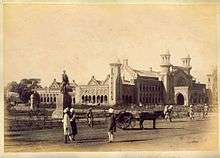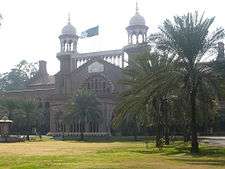Lahore High Court
| Lahore High Court عدالت عالیہ لاہور | |
|---|---|
|
High Court Building | |
| Established | 1919 |
| Country |
|
| Location | Shahra-e-Quaid-e-Azam, Lahore - Pakistan Lahore |
| Composition method | Presidential with confirmation of Chief Justice of Pakistan and Governor of Punjab. |
| Authorized by | Constitution of Pakistan |
| Decisions are appealed to | Supreme Court of Pakistan |
| Judge term length | Till 62 years of age |
| Number of positions | 60 |
| Website | www.lhc.gov.pk |
| Chief Justice | |
| Currently | Hon'ble Chief Justice Mr.Syed Mansoor Ali Shah |
| Since | 06 November 2015 |
| Lead position ends | 04 August 2022 |
The Lahore High Court is based in Lahore, Punjab, Pakistan. It was established as a high court on 21 March 1919.[1] The Lahore High Court has jurisdiction over Punjab. The High Court's principal seat is in Lahore, but there are benches in three other Pakistani cities: Rawalpindi, Multan and Bahawalpur. A proposal was sent by lawyers to set up new high court benches in Faisalabad, Sialkot, D.G.Khan and Gujranwala divisions but full court of Lahore High Court turned down this request.
History
Creation

For the first time in 1849, a Board of Administration was constituted and Punjab was divided into Divisions, Divisions into Districts and Districts into Tehsils. The Divisions were under the charge of Commissioners, Districts were controlled by Deputy Commissioners and Tehsils were supervised by Assistant and Extra Assistant Commissioners. By 1864, the necessity of expanding judicial machinery was keenly felt. A bill for the formation of the Chief Court of the Punjab was introduced on 16 February 1866 and the Chief Court Act-IV of 1866 was promulgated by the Governor General. On 17.02.1866, two Judges were appointed and in the same year, a Civil Procedure Code was made applicable to the courts. In 1884, the following classes of courts, subordinate to the Chief Court were constituted:-
- The Divisional Court.
- The Court of the District Judge.
- Court of the Subordinate Judge.
- The Court of Munsif.
In 1919, by King-Emperor George V the letters patent also appointed a Chief Justice and six puisne justices, and declared the Court's jurisdiction over the Punjab and Delhi provinces. the Chief Court was elevated to the status of a High Court by Letters Patent and in pursuance of a notification dated 1 April 1919. The Government of India Act, 1935 made certain radical changes in the Constitution and powers of the various High Courts in the British India. The new Act provided that Judges would hold office during good behavior whereas, previously they held office during his Majesty’s pleasure. Instead of the ceiling of twenty Judges fixed by the previous Act, the new Act left it to his Majesty to fix the number of Judges separately for each High Court depending upon their requirements. All acting appointments of Judges were left in the hands of the Governor-General and powers of the Local Governments were withdrawn. Under the old system, the Chief Justice had always been a Barrister Judge, however, the new Act removed this barrier and opened the Chief Justice-ship to Civilian Judges as well. The old Act fixed a definite proportion of Civilian and Barrister Judges in the composition of the High Court which was removed by the new Act. The new Act also fixed the 60 years age limit for the High Court Judges which did not exist in the old Act but which was otherwise enforced by the terms of the Judges’ appointment. By virtue of the Government of India (High Court Judges) Order, 1937, maximum number of Judges for the several High Courts in India was fixed. In each case the number so stated was exclusive of the Chief Justice but included all additional judges. The maximum number of Judges fixed for the Lahore High Court was 15. The said Order also prescribed the scale of pay and rights as to leave, pension and gratuity etc. of the Judges serving in the different High Courts in India including the Lahore High Court.
Independence of Pakistan
On 14 August 1947, the independence of two new independent countries of India and Pakistan also split the territory within the jurisdiction of the Lahore High Court. The High Court (Punjab) Order, 1947 created a new High Court for East Punjab (in India), leaving the court at Lahore responsible for the part of its original jurisdiction that now formed part of Pakistan. The Order left the powers afforded to the Court unchanged, but gave transferred the power of judicial appointment to the Governor-General of Pakistan instead of the Crown as beforehand. On 28 September 1948, the Governor General Khawaja Nazimuddin set the number of permanent judges at six, with one additional judge.
Establishment of West Pakistan
On 30 September 1955, the Constituent Assembly of Pakistan established the province of West Pakistan, and gave the Governor-General the power to establish a High Court for West Pakistan to replace the Lahore High Court; the West Pakistan High Court was accordingly established in 1956. Judges from the Chief Court of Sind and the Judicial Commissioners Court at Peshawar became judges at the West Pakistan High Court.
Creation Of Divisional Benches
On 1 January 1981, it was ordered that the Lahore High Court would create benches at Bahawalpur, Multan and Rawalpindi. The order also specified that the Lahore High Court judges could hold circuit courts anywhere in the province, with judges nominated by the Lahore High Court Chief Justice.
PCO 25 March 1981
The PCO of 1981 also afforded the Lahore High Court these three benches. The judges were required to take oath under the Provisional Constitutional Order. Four judges refused to do so and were relieved of office. Four other judges were not administered the oath, and were also relieved of office.[2]
PCO 26 January 2000
- Sir Rashid Aziz Khan Took oath under PCO
- Mian Allah Nawaz Took oath under PCO
- Falak Sher Took oath under PCO
- Ehsanul Haq Chaudhry Did not Take oath under PCO
- Tanvir Ahmad Khan Took oath under PCO
- Amir Alam Khan Took oath under PCO
- Iftikhar Hussain Chaudhry Took oath under PCO
- Fakhar-un-Nisa Khokhar Took oath under PCO
- Ghulam Mehmood Qureshi Took oath under PCO
- Karamat Nazir Bhandari Took oath under PCO
- Javed Buttar Took oath under PCO
- Mohammad Asif Jan Took oath under PCO
- Mohammad Nasim Chaudhri Took oath under PCO
- Mohammad Nawaz Abbasi, Took oath under PCO
- Tassadaq Hussain Jilani Took oath under PCO
- Raja Mohammad Sabir Took oath under PCO
- Syed Zahid Hussain Took oath under PCO
- Munir Ahmad Mughal Took oath under PCO
- Fakir Mohammad Khokar Took oath under PCO
- Abdul Razzaq Sheikh Took oath under PCO
- Zafar Pasha Chaudhary Took oath under PCO
- Mumtaz Ali Mirza Took oath under PCO
- Asif Saeed Khan Khosa Took oath under PCO
- Ch. Ijaz Ahmad Took oath under PCO
- Iftikhar Ahmad Cheema Took oath under PCO
- Jawad S Khawaja Took oath under PCO
- Khwaja Mohammad Sharif Took oath under PCO
- Mian Mohammad Najam-uz-Zaman Took oath under PCO
- Mian Saqib Nisar Took oath under PCO
- Mian Zafar Yasin Took oath under PCO
- Riaz Kayani Took oath under PCO
- Najamul Hassan Kazmi Did not Take oath under PCO
- Syed Jamshed Ali Took oath under PCO
- Khalil-ur-Rehman Ramday Took oath under PCO
- Malik Mohammad Qayyum Took oath under PCO
- Nazir Akhtar Took oath under PCO
- Ali Nawaz Chohan Took oath under PCO
- Bashir A Mujahid Took oath under PCO
- Naeemullah Sherwani Took oath under PCO
- Molvi Anwar-ul-Haq Took oath under PCO
- Akhtar Shabbir Took oath under PCO
- Naseem Sikandar Took oath under PCO
- Nazir Siddique Took oath under PCO
PCO 3 November 2007
- Iftikhar Hussain Ch Take oath under PCo as chief justice
- Khawja Muhammad Sharif Refused oath under PCo
- Sayyed Zahid Hussain Take oath under PCo
- Mian M Najamuz Zaman Take oath under PCo
- Mian Saqib Nisar Refused oath under PCo
- Asif Saeed Khan Khosa Refused oath under PCo
- Maulvi Anwarul Haq Take oath under PCo
- Nasim Sikandar Take oath under PCo
- Abdul Shakoor Paracha Take oath under PCo
- Mohammad Khalid Alvi Take oath under PCo
- Muhammad Sair Ali Refused oath under PCo
- Ijaz Ahmad Chaudhry, Refused oath under PCo
- Mian Hamid Farooq Take oath under PCo
- M. Bilal Khan Take oath under PCo
- Fazale Miran Chauhan Take oath under PCo
- Syed Shabbar Raza Rizvi Take oath under PCo
- M. A. Shahid Siddiqui Refused oath under PCo
- Syed Sakhi Hussain Bokhari Take oath under PCo
- Sardar Mohammad Aslam Take oath under PCo
- Sheikh Hakim Ali Take oath under PCo
- Mohammad Muzammal Khan Take oath under PCo
- Muhammad Jhangir Arshad Refused oath under PCo
- Sh. Azmat Saeed Refused oath under PCo
- Syed Hamid Ali Shah Take oath under PCo
- Umar AttaBandial Refused oath under PCo
- Sh. Javaid Sarfraz Take oath under PCo
- Syed Sajjad Hussain Shah Take oath under PCo
- Tariq Shamim Take oath under PCo
- Syed Asghar Haider Take oath under PCo
- Hasnat Ahmad Khan Take oath under PCo
- Iqbal Hameed-ur-Rehman Refused oath under PCo
See also
- High Courts of Pakistan
- List of the Chief Justices of Lahore High Court
- Constitution of Pakistan
- Islamabad High Court
- Balochistan High Court
- Peshawar High Court
- Sindh High Court
- Court system of Pakistan
- Punjab Bar Council
References
- ↑ N. R. Madhava Menon, ed. (2002). Criminal Justice India Series: Punjab, 2002. Allied Publishers. p. 234. ISBN 978-81-7764-490-6.
- ↑ "History of the High Court". Lahore High Court. Retrieved May 2013. Check date values in:
|access-date=(help)
